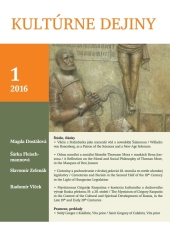Cintoríny a pochovávanie v druhej polovici 18. storočia vo svetle uhorskej legislatívy
Cemeteries and Burials in the Second Half of the 18th Century in the Light of Hungarian Legislation
Author(s): Slavomír ZelenákSubject(s): History
Published by: VERBUM - vydavateľstvo Katolíckej univerzity v Ružomberku
Keywords: cemetery; burial; care; regulation; law; law-book; monarch; emperor; 18th century
Summary/Abstract: The second half of the 18th century and the turn of the 18th and the 19th centuries was a very important age in the field of funeral and cemetery management. Due to the frequent occurrence of epidemics, the Vienna Court was seeking to improve the level of public health services. One of the ways was the reform of funerals. Cemetery maintenance was of a low quality. Cemeteries often did not have any fences and cattle were pastured there, graves were very shallow and there were also many other negative factors. All these facts meant a serious risk to public health and the Vienna Court decided to solve this situation. The author of this article provides a look at the measures, which were taken during the reigns of Maria Theresa, Josef II and Leopold I. Some laws were enacted by the Hungarian Vice-regency Council itself. The author presents in detail not only the wording of these regulations, but also their overall importance. At the end of the article, he makes an assessment of their overall contribution to cemetery maintenance and to public health.Humanism and the Renaissance was a period when many well-established religious traditions had to give way to more rational and practical views in many areas of social life. The area of funerals was no exception, and as early as during the Renaissance period, the impact of cemeteries on public health increasingly began to be revaluated. During the period of absolutism, no more radical reforms in this area came to Hungary. It was just the Viennese government court, which opened up Hungary for many reforms that had already been realised in Western Europe. Maria Theresa was the first monarch, who embarked on major reforms. A frequent occurrence of epidemics required strong measures and one of the ways to prevent their occurrence was to increase cemetery maintenance. It was just a question of public health, which set in motion a series of important measures. The most important of Maria Theresa´s reforms was the so-called “Regulatio coemeteriorum”, which ordered that cemeteries should be set up outside a built-up area and fenced properly because of freely moving cattle and game. Also ordered was the rational filling up of cemeteries in rows, regardless of family membership. These regulations came into force in Hungary, in 1777, when they were released by the Hungarian Vice-regency Council. Joseph II continued the course, in addition to his mother’s regulations he ordered a grave depth, grave dimensions and other detailed parameters of the internal equipment, as well as burials without coffins in linen bags. The problem was that the validity of the regulations was limited to the period of his reign. However, on his proposal, the Hungarian Council enacted several regulations, mainly related to tomb building in cemeteries and frequent shallow burials. The Hungarian Council continued this tendency during the reign of Leopold II and also in the first half of the 19th century; whether on the emperor’s suggestion or on the basis of local conditions, they issued a number of local regulations concerning not only insufficient cemetery fencing, but also a grave depth that was on average about 5 feet. The variety and wording of the single regulations show us not only a unique picture of low level cemetery maintenance in Hungary, before the reign of Maria Theresa, but also highlights the great contribution of the Viennese Court reforms for the territory of Hungary. The result was a detailed record of the situation in single areas, which must have left its mark on the real overall level of public health.
Journal: Kultúrne dejiny
- Issue Year: 7/2016
- Issue No: 1
- Page Range: 35-51
- Page Count: 17
- Language: Slovak

